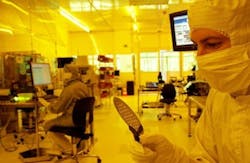Microphone listens and locates sound sources with optical position sensors
Oslo, Norway--A millimeter-sized optical position detector developed by scientists at SINTEF’s Micro and Nano Fabrication Facility (MiNaLab) is aimed at making microphones hypersensitive.
Researcher Matthieu Lacolle says that in the SINTEF device, a microscopically small laser is used to measure the distance between a microphonic surface and a reference surface. If the membrane is made light enough and allowed to oscillate freely in the air, the microphone also becomes directionally sensitive. To achieve this, the membrane was made only 100 nm thick. The optical sensor itself is diffraction-based and can sense membrane movements of less than the diameter of an atom.
The reference surface has grooved microstructures that lie directly underneath the microphone membrane. "When the laser illuminates these microstructures, we can read off the direction in which the light is reflected by means of photodetectors," says Lacolle.
“Think of traditional videoconference equipment," he adds. "Several people are sitting around the table, but the microphone has been placed where its sound reception is less than optimal. With technology of this sort, a microphone will be able to 'see' where the sound comes from, pick up the voice of the person speaking, and filter out other sources of noise in the room." Lacolle notes that acoustics scientists at SINTEF also contributed to the device.
Everything is integrated into a miniaturized circuit that is mass-produced on a silicon wafer on which all the structures are etched. In MiNaLab’s clean room, production takes place in a highly controlled environment.
Will go into commercial products
The Norwegian company Norsonic, which supplies various types of noise-measurement equipment, intends to use the new microphone to measure both sound pressure and acoustic power. “The microphone is the very heart of the equipment that we supply,” says senior scientist Ole Herman Bjor in Norsonic. "What is unique about this technology is that it can give us an extremely sensitive microphone that is capable of registering sound waves far beyond the range that microphones in this price class can do today. This lets us compete in a market that is currently occupied by very expensive equipment. Our version is also much smaller, which is an advantage in itself, because the physical size of the microphone actually affects the sound field that it is measuring."
SINTEF lists other potential uses for the sensor as:
• geophones for seismic shooting
• photoacoustic gas sensors
• accelerometers
• vibration sensors
• gyroscopes
• pressure sensors
• high-temperature versions of the above-mentioned sensors
• sensors for highly irradiated sites (nuclear power stations, x-ray equipment) or that are bathed in electromagnetic radiation (sensors in motors or magnetic resonance equipment)
Source: http://www.alphagalileo.org/ViewItem.aspx?ItemId=132163&CultureCode=en
About the Author
John Wallace
Senior Technical Editor (1998-2022)
John Wallace was with Laser Focus World for nearly 25 years, retiring in late June 2022. He obtained a bachelor's degree in mechanical engineering and physics at Rutgers University and a master's in optical engineering at the University of Rochester. Before becoming an editor, John worked as an engineer at RCA, Exxon, Eastman Kodak, and GCA Corporation.

